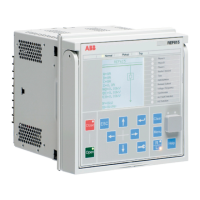20. Station communication
The relay supports a range of communication pro-
tocols including IEC 61850 Edition 2, IEC 61850-9-2
LE, Modbus® and DNP3. Operational information
and controls are available through these protocols.
However, some communication functionality, for
example, horizontal communication between the
relays, is only enabled by the IEC 61850 communica-
tion protocol.
The IEC 61850 protocol is a core part of the relay as
the protection and control application is fully
based on standard modelling. The relay supports
Edition 2 and Edition 1 versions of the standard.
With Edition 2 support, the relay has the latest
functionality modelling for substation applications
and the best interoperability for modern substa-
tions. It incorporates also the full support of stan-
dard device mode functionality supporting differ-
ent test applications. Control applications can
utilize the new safe and advanced station control
authority feature.
The IEC 61850 communication implementation sup-
ports monitoring and control functions. Addition-
ally, parameter settings, disturbance recordings
and fault records can be accessed using the IEC
61850 protocol. Disturbance recordings are avail-
able to any Ethernet-based application in the stan-
dard COMTRADE file format. The relay supports si-
multaneous event reporting to five different clients
on the station bus. The relay can exchange data
with other devices using the IEC 61850 protocol.
The relay can send binary and analog signals to
-
neric Object Oriented Substation Event) profile. Bi-
-
ployed for protection and interlocking-based
performance requirements for tripping applica-
tions in distribution substations, as defined by the
IEC 61850 standard (<10 ms data exchange be-
tween the devices). The relay also supports the
sending and receiving of analog values using
-
ables easy transfer of analog measurement values
over the station bus, thus facilitating for example
the sending of measurement values between the
relays when controlling parallel running transform-
ers.
The relay also supports IEC 61850 process bus by
sending sampled values of analog currents and
voltages and by receiving sampled values of volt-
ages. With this functionality the galvanic interpanel
wiring can be replaced with Ethernet communica-
tion. The measured values are transferred as sam-
pled values using IEC 61850-9-2 LE protocol. The in-
tended application for sampled values shares the
voltages to other 615 series relays, having voltage
based functions and 9-2 support. 615 relays with
process bus based applications use IEEE 1588
for high accuracy time synchronization.
For redundant Ethernet communication, the relay
offers either two optical or two galvanic Ethernet
network interfaces. A third port with galvanic Eth-
ernet network interface is also available. The third
Ethernet interface provides connectivity for any
other Ethernet device to an IEC 61850 station bus
inside a switchgear bay, for example connection of
achieved using the high-availability seamless re-
dundancy (HSR) protocol or the parallel redundancy
protocol (PRP) or a with self-healing ring using
RSTP in managed switches. Ethernet redundancy
can be applied to Ethernet-based IEC 61850, Mod-
bus and DNP3 protocols.
The IEC 61850 standard specifies network redun-
dancy which improves the system availability for
the substation communication. The network redun-
dancy is based on two complementary protocols
defined in the IEC 62439-3 standard: PRP and HSR
protocols. Both the protocols are able to overcome
a failure of a link or switch with a zero switch-over
time. In both the protocols, each network node has
two identical Ethernet ports dedicated for one net-
work connection. The protocols rely on the duplica-
tion of all transmitted information and provide a
zero switch-over time if the links or switches fail,
thus fulfilling all the stringent real-time require-
ments of substation automation.
In PRP, each network node is attached to two inde-
pendent networks operated in parallel. The net-
works are completely separated to ensure failure
independence and can have different topologies.
The networks operate in parallel, thus providing ze-
ro-time recovery and continuous checking of re-
dundancy to avoid failures.
30 REF615 ANSI 5.0 FP1 FEEDER PROTECTION AND CONTROL

